Faculty Publications
Journals
Reed Magazine: A Journal of Poetry and Prose
San Jose State University's Literary Magazine featuring submissions of original poetry and short stories from across the nation. Reed Magazine is one of the oldest student publications west of the Mississippi. In its earlier incarnations it was called El Portal. Reed was first numbered by year and volume in 1946. At the time, the magazine was put together by SJSU's literary society, Pegasus, with help from the Associated Student Body. The magazine continues to be compiled and edited by students in the Department of English & Comparative Literature programs.
Steinbeck Review
Steinbeck Review is the authorized publication on the life and works of John Steinbeck. It publishes scholarly articles, essays, photographs, notes, book and performance review, and contemporary references about the author. Manuscripts are subject to blind peer review. Steinbeck Review is issued twice yearly and includes a membership in the Steinbeck Society. Members will be informed of panels at the American Literature Association as well as events sponsored by the Martha Heasley Cox Center for Steinbeck Studies and the National Steinbeck Center.
Purchase These and Other Books!
Shop Amazon.com
By entering Amazon through this link, Amazon will return 8.5% of any purchase to our Department. Free shipping on most orders over $25.
Shop Barnes & Noble
Shop Powells.com
Publications
Selena Anderson
"A Shameful Citizen" in American Short Fiction 72
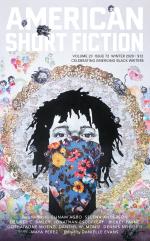 Celebrating emerging Black writers: featuring new stories by Elinam Agbo, Selena Anderson,
Desiree C. Bailey, Jonathan Escoffery, Rickey Fayne, Gothataone Moeng, Dantiel W.
Moniz, Dennis Norris II, and Maya Perez.
Celebrating emerging Black writers: featuring new stories by Elinam Agbo, Selena Anderson,
Desiree C. Bailey, Jonathan Escoffery, Rickey Fayne, Gothataone Moeng, Dantiel W.
Moniz, Dennis Norris II, and Maya Perez.
Guest-edited by Danielle Evans.
Best American Short Stories 2020
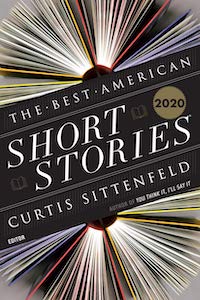 “To read their stories felt to me the way I suspect other people feel hearing jazz
for the first time,” recalls Curtis Sittenfeld of her initial encounter with the Best American Short Stories series. “They were windows into emotions I had and hadn’t had, into other settings
and circumstances and observations and relationships.” Decades later, Sittenfeld was
met by the same feeling selecting the stories for this year’s edition. The result
is a striking and nuanced collection, bringing to life awkward college students, disgraced
public figures, raunchy grandparents, and mystical godmothers. To read these stories
is to experience the transporting joys of discovery and affirmation, and to realize
that story writing in America continues to flourish.
“To read their stories felt to me the way I suspect other people feel hearing jazz
for the first time,” recalls Curtis Sittenfeld of her initial encounter with the Best American Short Stories series. “They were windows into emotions I had and hadn’t had, into other settings
and circumstances and observations and relationships.” Decades later, Sittenfeld was
met by the same feeling selecting the stories for this year’s edition. The result
is a striking and nuanced collection, bringing to life awkward college students, disgraced
public figures, raunchy grandparents, and mystical godmothers. To read these stories
is to experience the transporting joys of discovery and affirmation, and to realize
that story writing in America continues to flourish.
Tiny Nightmares: Very Short Tales of Horror
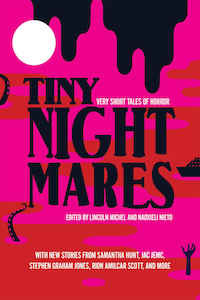 In this playful, inventive collection, leading literary and horror writers spin chilling
tales in only a few pages. Each slim, fast-moving story brings to life the kind of
monsters readers love to fear, from brokenhearted vampires to Uber-taking serial killers
and mind-reading witches. But what also makes Tiny Nightmares so bloodcurdling―and
unforgettable―are the real-world horrors that writers such as Samantha Hunt, Brian
Evenson, Jac Jemc, Stephen Graham Jones, Lilliam Rivera, Kevin Brockmeier, and Rion
Amilcar Scott weave into their fictions, exploring how global warming, racism, social
media addiction, and homelessness are just as frightening as, say, a vampire’s fangs
sinking into your neck. Our advice? Read with the hall light on and the bedroom door
open just a crack.
In this playful, inventive collection, leading literary and horror writers spin chilling
tales in only a few pages. Each slim, fast-moving story brings to life the kind of
monsters readers love to fear, from brokenhearted vampires to Uber-taking serial killers
and mind-reading witches. But what also makes Tiny Nightmares so bloodcurdling―and
unforgettable―are the real-world horrors that writers such as Samantha Hunt, Brian
Evenson, Jac Jemc, Stephen Graham Jones, Lilliam Rivera, Kevin Brockmeier, and Rion
Amilcar Scott weave into their fictions, exploring how global warming, racism, social
media addiction, and homelessness are just as frightening as, say, a vampire’s fangs
sinking into your neck. Our advice? Read with the hall light on and the bedroom door
open just a crack.
2020 Emerging Texas Star Award from American Short Fiction
Gina Arnold
Gina Arnold's books are all about music, media, performance and the experience of seeing rock concerts.
"Half a Million Strong: Crowds and Power at American Rock Festivals From Woodstock to Coachella." University of Iowa Press, 2018.
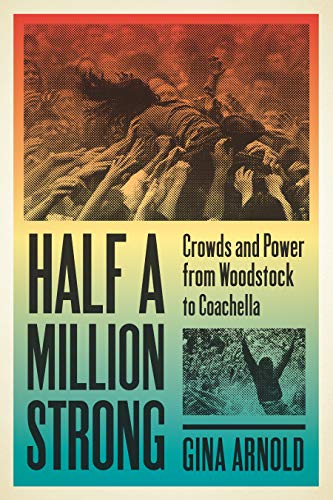 From baby boomers to millennials, attending a big music festival has basically become
a cultural rite of passage in America. In Half a Million Strong, music writer and scholar Gina Arnold explores the history of large music festivals
in America and examines their impact on American culture. Studying literature, films,
journalism, and other archival detritus of the countercultural era, Arnold looks closely
at a number of large and well-known festivals, including the Newport Folk Festival,
Woodstock, Altamont, Wattstax, the New Orleans Jazz and Heritage Festival, Hardly
Strictly Bluegrass, and others to map their cultural significance in the American
experience. She finds that—far from being the utopian and communal spaces of spiritual
regeneration that they claim for themselves— these large music festivals serve mostly
to display the free market to consumers in its very best light.
From baby boomers to millennials, attending a big music festival has basically become
a cultural rite of passage in America. In Half a Million Strong, music writer and scholar Gina Arnold explores the history of large music festivals
in America and examines their impact on American culture. Studying literature, films,
journalism, and other archival detritus of the countercultural era, Arnold looks closely
at a number of large and well-known festivals, including the Newport Folk Festival,
Woodstock, Altamont, Wattstax, the New Orleans Jazz and Heritage Festival, Hardly
Strictly Bluegrass, and others to map their cultural significance in the American
experience. She finds that—far from being the utopian and communal spaces of spiritual
regeneration that they claim for themselves— these large music festivals serve mostly
to display the free market to consumers in its very best light.
Other Publications
Co-Editor, "The Oxford Handbook of Punk," Oxford University Press, 2021
Co-Editor, "Music/Video: History/Aesthetics/Media. Bloomsbury Academic, 2017
"Exile In Guyville," Bloomsbury Academic, 2014
"Kiss This" St. Martin's Press, 1997
"Route 666: On the Road To Nirvana," St. Martin's Press, 1993
Sally Ashton
A Cast-Iron Aeroplane That Can Actually Fly: Commentaries from 80 American Poets on their Prose Poems, ed. Peter Johnson (2019)
“[A] solid collection of prose poems written by some of the best American practitioners of the genre. It also provides a good way of looking at the prose poem as a legitimate genre by focusing on what the poets themselves have to say [about their own work].… As the … commentaries suggest, hearing poets describe their writing processes can often situate their prose poems in a broader literary, historical, and cultural context, and may even help us to evaluate and appreciate their poems.”
—Peter Johnson
Some Odd Afternoon
"This is about what turns up," writes Sally Ashton in Some Odd Afternoon. What turns up may be the "dangedy-dang twang' of a banjo, a laptop hiding under a hoop skirt, or a living room that becomes a forest of grandfathers, one "a log, another stone, one a river." To step into the opening line of one of her poems is to venture out into a future as uncertain and marvelous as the one unfolding before the youngest son in a fairy tale. We understand how wide the world is when Attention, freed from its daily constraints, becomes a wanderer.
- Nils Peterson
The Behaviour of Clocks (2019)
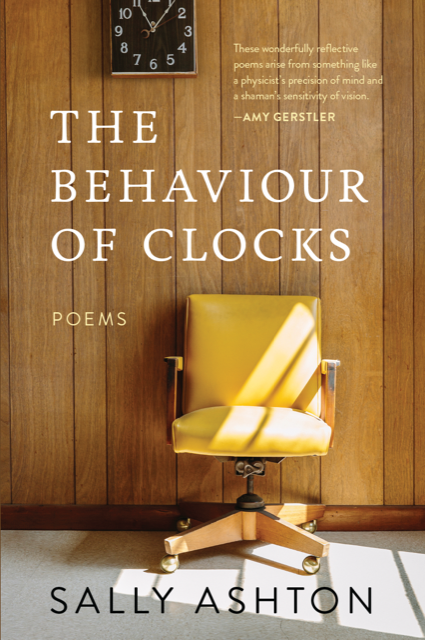 Albert Einstein's thought experiments frame Sally Ashton's new collection of prose
poems. Here she offers a poetic inquiry into time—the simultaneity of the past, present,
and future in how each informs any moment. Fellow poet Amy Gerstler writes, "Ashton's
investigative meditations maintain constant awareness of territories shared by physics
and poetry. These wonderfully reflective poems arise from something like a physicist's
precision of mind and a shaman's sensitivity of vision."
Albert Einstein's thought experiments frame Sally Ashton's new collection of prose
poems. Here she offers a poetic inquiry into time—the simultaneity of the past, present,
and future in how each informs any moment. Fellow poet Amy Gerstler writes, "Ashton's
investigative meditations maintain constant awareness of territories shared by physics
and poetry. These wonderfully reflective poems arise from something like a physicist's
precision of mind and a shaman's sensitivity of vision."
Her Name is Juanita (Kore Press, 2009)
"Ashton is a poet, writer, teacher, and editor of the DMQ Review, an online journal featuring poetry and art. She is author of Some Odd Afternoon, BlazeVOX, 2010, and a prose poem collection, Her Name Is Juanita, Kore Press, 2009. Both books received Pushcart Prize nominations. These Metallic Dayswas published in 2005 as part of Main Street Rag’s Editor’s Choice Chapbook Series. Poems also appear in An Introduction to the Prose Poem, and Breathe: 101 Contemporary Odes, as well as journals such as Sentence: A Journal of Prose Poetics, 5am, Mississippi Review and Poet Lore."
Zehlia Babaci-Wilhite
Learning Critical Thinking Skills Beyond the 21st Century for Multidisciplinary Courses: A Human Rights Perspective in Education
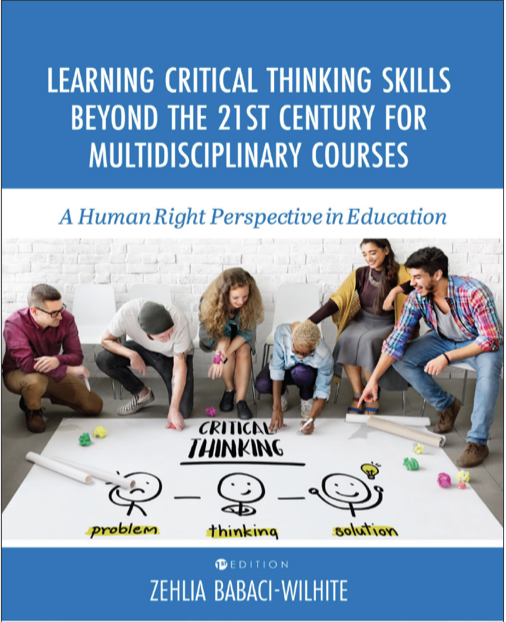 Featuring contributed chapters written by experts within
Featuring contributed chapters written by experts within
the field, Learning Critical Thinking Skills Beyond the 21st
Century for Multidisciplinary Courses: A Human Rights
Perspective in Education provides readers with various
perspectives regarding the intersection of education, human rights, and critical thinking.
The text integrates strategies and best practices that support equitable education,
elevate human rights, and pave the way for a better future. The text is divided into
four modules. In Module 1, readers learn about the history and evolution of human
rights, how students can integrate language arts and human rights into STEM/STEAM
subjects, and how critical teaching and social justice teaching can increase students’
involvement and understanding. Module 2 features scholarship on leadership and inclusion
in cross-cultural and multidisciplinary critical thinking, field theory as a means
to analyze the social world critically, and the need across the disciplines for high-quality
critical thinking. In Module 3, chapters speak to the critical nature of cultural
learning and individual life experience in the quest for sustainability, the dynamics
of cultural encounters, the correlation between art and mathematics from an instructional
aspect, and how digital storytelling can foster greater academic literacy. The final
module features chapters on humanistic literacy, strategies to enhance global literacy,
and critical and cultural literacy.
Promoting Language and STEAM as Human Rights in Education (2019)
 This book argues that integrating artistic contributions – with an emphasis on culture
and language – can make Science, Technology, Engineering and Mathematics (STEM) subjects
more accessible, and therefore promote creativity and innovation in teaching and learning
at all levels of education. It provides tools and strategies for managing interdisciplinary
learning and teaching based on successful collaborations between researchers, practitioners
and artists in the fields of the Arts and STEM subjects. Based on contributions by
educators, scientists, scholars, linguists and artists from around the globe, the
book highlights how we can demonstrate teamwork and collaboration for innovation and
creativity in STEAM subjects in the classroom and beyond.
This book argues that integrating artistic contributions – with an emphasis on culture
and language – can make Science, Technology, Engineering and Mathematics (STEM) subjects
more accessible, and therefore promote creativity and innovation in teaching and learning
at all levels of education. It provides tools and strategies for managing interdisciplinary
learning and teaching based on successful collaborations between researchers, practitioners
and artists in the fields of the Arts and STEM subjects. Based on contributions by
educators, scientists, scholars, linguists and artists from around the globe, the
book highlights how we can demonstrate teamwork and collaboration for innovation and
creativity in STEAM subjects in the classroom and beyond.
Other Publications
A book chapter entitled: Improving Critical Thinking in STEM for Girls: A Contextualized Education Integrating the Arts and Human Rights. In Robert Arnove, Carlos Alberto Torres, and Lauren Misiaszek (Eds), 5th Edition. Comparative Education: the Dialectic of the Global and the Local. Rowman & Littlefield (Forthcoming).
Noelle Brada-Williams
Asian American Literature: Discourses & Pedagogies
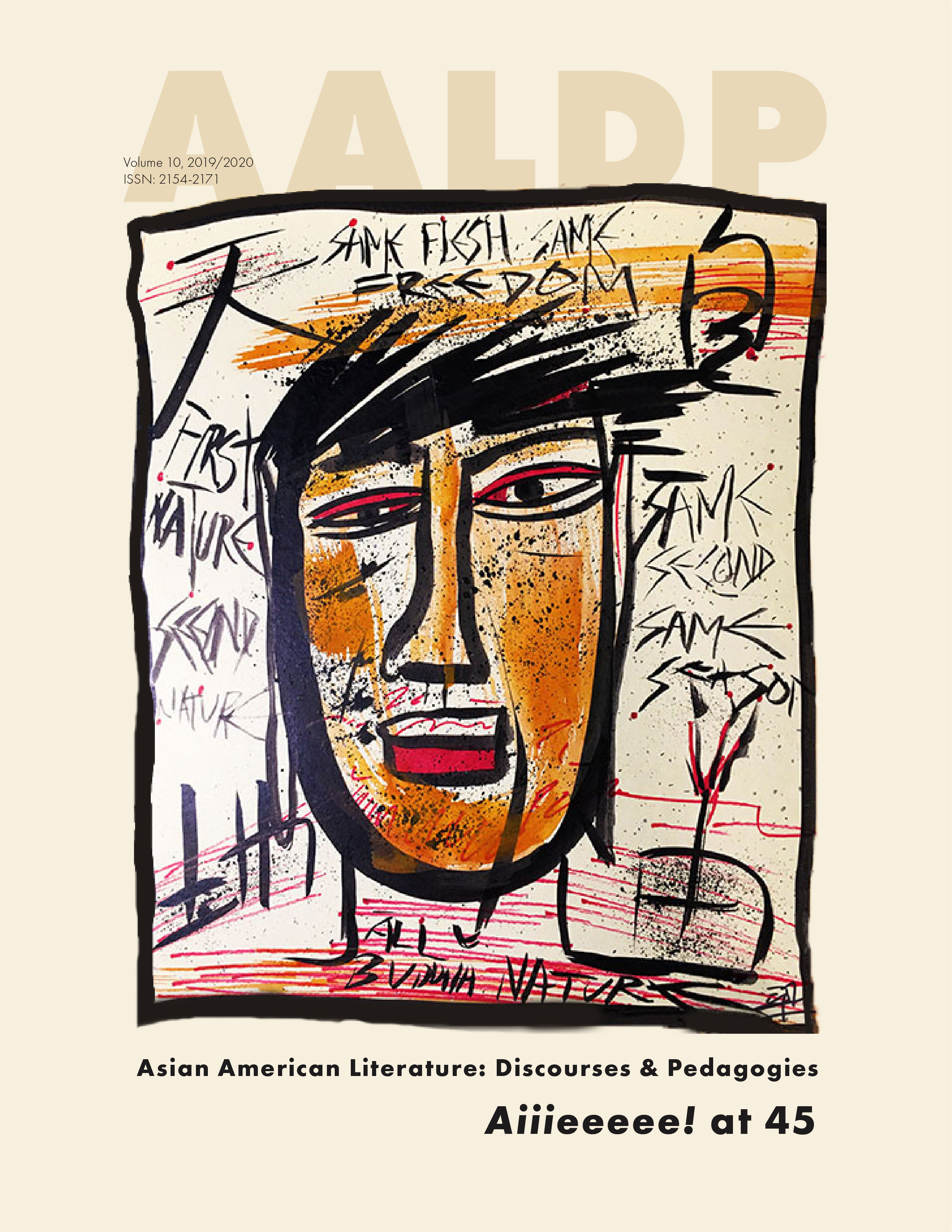 Asian American Literature: Discourses & Pedagogies focuses on the production, collection, and distribution of accessible high quality
research on Asian American Literature for students, teachers, and the general public.
Asian American Literature: Discourses & Pedagogies focuses on the production, collection, and distribution of accessible high quality
research on Asian American Literature for students, teachers, and the general public.
Crossing Oceans: Reconfiguring American Literary Studies in the Pacific Rim (Hong Kong University Press, 2004)
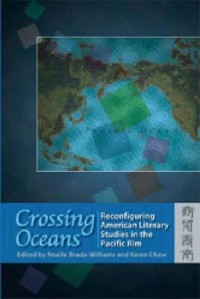 With the increasing globalization of culture, American literature has become a significant
body of text for classrooms outside of the United States. Bringing together essays
from a wide range of scholars in a number of countries, including China, Japan, Korea,
Singapore, and the United States, Crossing Oceans focuses on strategies for critically
reading and teaching American literature, especially ethnic American literature, within
the Asia Pacific region. This book will be an important tool for scholars and teachers
from around the globe who desire fresh perspectives on American literature from a
variety of national contexts.
With the increasing globalization of culture, American literature has become a significant
body of text for classrooms outside of the United States. Bringing together essays
from a wide range of scholars in a number of countries, including China, Japan, Korea,
Singapore, and the United States, Crossing Oceans focuses on strategies for critically
reading and teaching American literature, especially ethnic American literature, within
the Asia Pacific region. This book will be an important tool for scholars and teachers
from around the globe who desire fresh perspectives on American literature from a
variety of national contexts.
Related Information
Adrienne L. Eastwood
The Widow Ranter (Broadview Press, 2022)
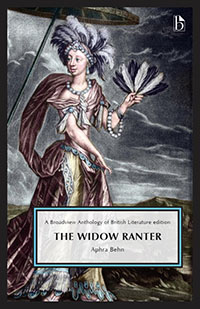 In her final play, Aphra Behn looks across the Atlantic and reimagines Bacon’s Rebellion, the notorious revolt whose participants
took up arms against the government of colonial Virginia with the aim of driving the
Indigenous population from the region. Heavily fictionalized and featuring a memorable
cast of both heroic and comic characters, Behn’s long-neglected tragicomedy is an
important and entertaining contribution to the catalogue of transatlantic and Restoration
literature. This edition supplements the play with an informative introduction and
a robust selection of historical documents that situate it in the context of the historical
rebellion and of late-seventeenth-century discourses around empire and colonization.
In her final play, Aphra Behn looks across the Atlantic and reimagines Bacon’s Rebellion, the notorious revolt whose participants
took up arms against the government of colonial Virginia with the aim of driving the
Indigenous population from the region. Heavily fictionalized and featuring a memorable
cast of both heroic and comic characters, Behn’s long-neglected tragicomedy is an
important and entertaining contribution to the catalogue of transatlantic and Restoration
literature. This edition supplements the play with an informative introduction and
a robust selection of historical documents that situate it in the context of the historical
rebellion and of late-seventeenth-century discourses around empire and colonization.
Michael Tod Edgerton
Vitreous Hide (Lavender Ink, 2013)
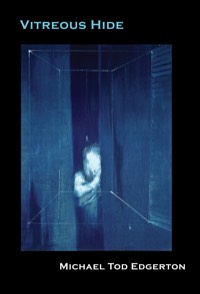
Willing the word to become flesh, the poems in Vitreous Hide both reveal and enact yearning—for love, for the beloved, for the words to transform beloved image to beloved substance. Orpheus reaches for Narcissus through a new mirror of myth, now dim with distance, now bright with the possibility of connection. Through the shining skin or surface of prose lines and field composition, these poems reach for the embodiment of the other in order to be, themselves, embodied.
"In a theater of the page permeated by sonic play...sound, made overtly and gorgeously lyric, becomes the dominant character, increasingly swept up into a dynamically choreographed typography. It’s a book of big ideas and big feeling, yet carried so lightly on its lyric weave that it becomes almost weightless. A real delight for both ear and mind."
- Cole Swensen
"[T]he gay erotics of this work...have no equivalent in modern American poetry. Really you’d have to go back in time and cross many seas...to hear so persuasive, alert, and stunning a love poem."
- Kevin Killian
"Edgerton is brilliant to announce that myth and the perils of myth are flesh of our flesh, the perdurable instance of our human birth."
- Donald Revell
Kristin FitzPatrick
My Pulse Is an Earthquake
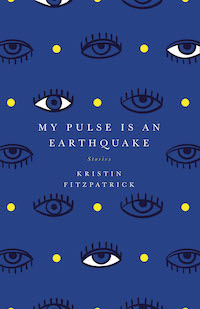 The nine stories in My Pulse Is an Earthquake take place in the clutches of grief. Characters struggle to make sense of sudden
losses of life, love, and community. From 1970 to the present day, children and young
adults from the Rockies to the Appalachian Mountains guide readers through the valleys
of their lives as dog breeders, immigrants, Catholic school delinquents, rookie policewomen,
drummers, ballerinas, teenage brides, and an accountant who keeps a careful inventory
of losses.
The nine stories in My Pulse Is an Earthquake take place in the clutches of grief. Characters struggle to make sense of sudden
losses of life, love, and community. From 1970 to the present day, children and young
adults from the Rockies to the Appalachian Mountains guide readers through the valleys
of their lives as dog breeders, immigrants, Catholic school delinquents, rookie policewomen,
drummers, ballerinas, teenage brides, and an accountant who keeps a careful inventory
of losses.
In each story, we see the darkness that can surface during the happy moments in life—weddings, births, promotions, the opening night of a director’s favorite play, or the best performance of a dancer’s career, when no one important is there to watch. We enter daydreams and night terrors where the dead are within reach, pointing out how they could have been saved. We wear their clothes and carry their teddy bears or vinyl records everywhere. We crawl around in caves and pound hammers into walls until our own hearts stop beating.
This collection explores how the unexpected harm to young, vibrant loved ones—from murder, kidnapping, battle, accident, natural disaster, swift illness, or stillbirth—can rupture families, and how the most unlikely healers can bring together those who remain.
Meghan Gorman-DaRif
Derailing the Rail: Indian-Kenyan Solidarity in Contemporary Anglophone Fiction
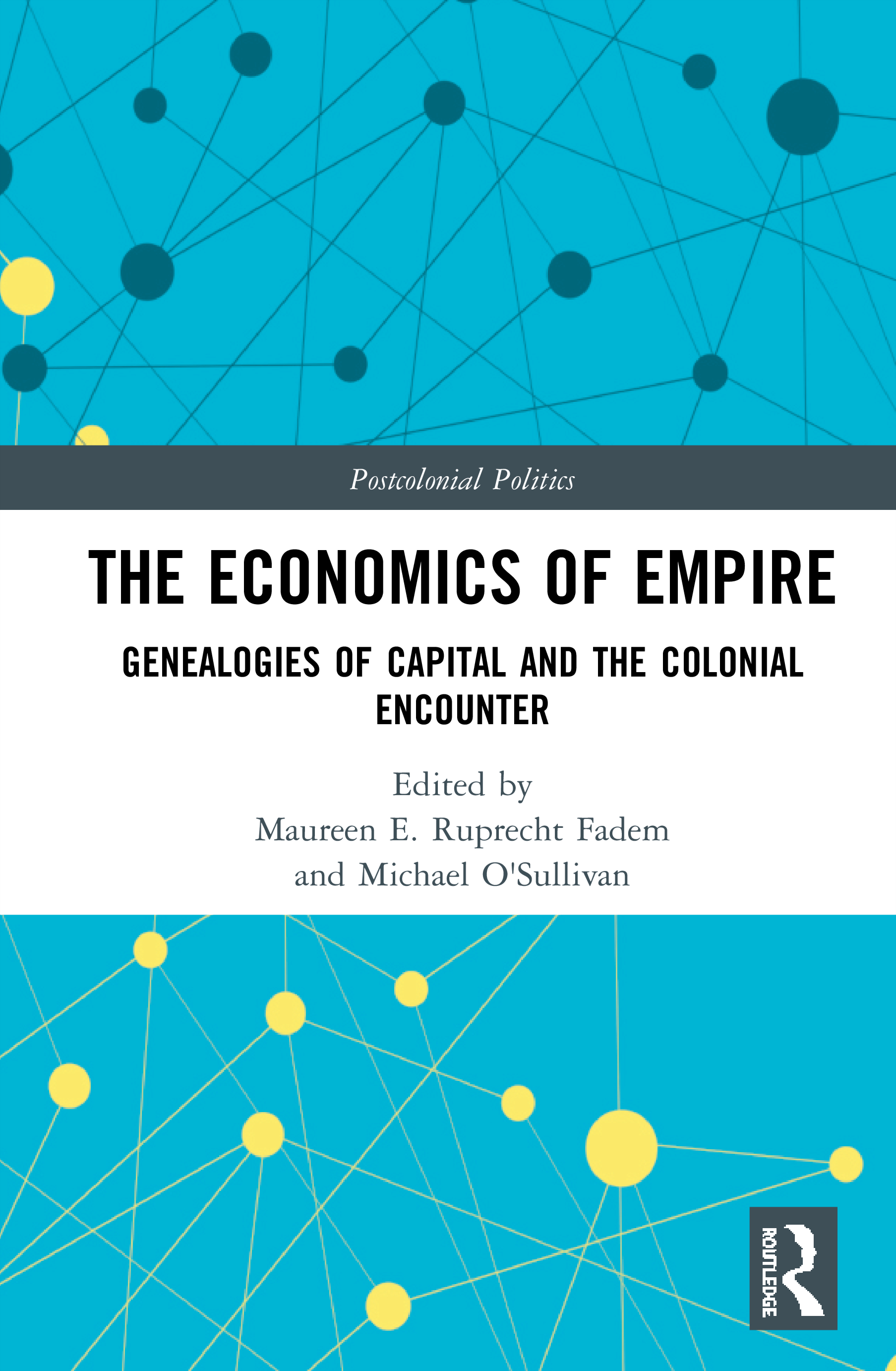 While contemporary Kenyan writing has focused extensively on colonial histories and
African resistance, particularly in relation to the 1952–60 Mau Mau Uprising, the
novels of M.G. Vassanji and Pater Kimani stand out in their focus on the Indian community
in Kenya, which, as Ngũgĩ wa Thiong’o has noted, has remained largely marginal and
invisible. This chapter analyzes representations of the Indian community in Kenya,
particularly in relation to the building of the railway beginning in 1895, through
a reading of Vassanji’s 2004 novel The In-Between World of Vikram Lall and Kimani’s
Dance of the Jakaranda, published in 2017. I argue that Vassanji’s novel largely resonates
with historiographical claims in its depiction of an ambivalent relationship between
Indians and Africans in Kenya, but that Kimani’s novel emphasizes solidarity, making
an important and timely intervention into imagining the African collective in the
aftermath of the post-election violence of 2007.
While contemporary Kenyan writing has focused extensively on colonial histories and
African resistance, particularly in relation to the 1952–60 Mau Mau Uprising, the
novels of M.G. Vassanji and Pater Kimani stand out in their focus on the Indian community
in Kenya, which, as Ngũgĩ wa Thiong’o has noted, has remained largely marginal and
invisible. This chapter analyzes representations of the Indian community in Kenya,
particularly in relation to the building of the railway beginning in 1895, through
a reading of Vassanji’s 2004 novel The In-Between World of Vikram Lall and Kimani’s
Dance of the Jakaranda, published in 2017. I argue that Vassanji’s novel largely resonates
with historiographical claims in its depiction of an ambivalent relationship between
Indians and Africans in Kenya, but that Kimani’s novel emphasizes solidarity, making
an important and timely intervention into imagining the African collective in the
aftermath of the post-election violence of 2007.
Sherri Harvey
Welcome to the Jungle!
 A story about a trip to Borneo to save the orangutans from extinction.
A story about a trip to Borneo to save the orangutans from extinction.
Katherine D. Harris
Digital Pedagogy in the Humanities: Concepts, Models, and Experiments
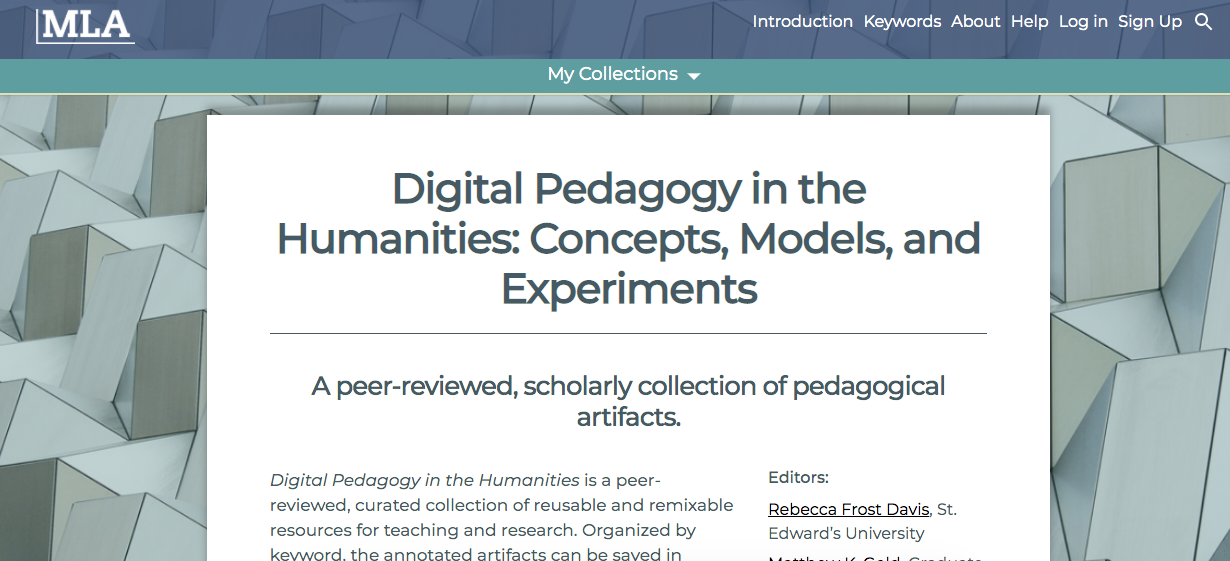
Edited by Rebecca Frost Davis, Matthew K. Gold, Katherine D. Harris, and Jentery Sayers.
Digital Pedagogy in the Humanities is an open access, peer-reviewed, curated collection of reusable and remixable resources
for teaching and research. Organized by keyword, the annotated artifacts can be saved
in collections for future reference or sharing. Each keyword includes a curatorial
statement and artifacts that exemplify that keyword. You can read the keywords comprehensively,
as you would a printed collection, and browse artifacts, exploring certain types or
subject matter.
Forget Me Not: The Rise of the British Literary Annual, 1823–1835
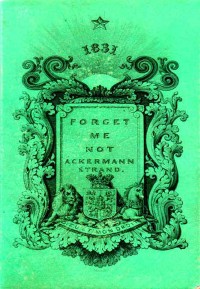 By November 1822, the British reading public had already voraciously consumed both
Walter Scott’s expensive novels and Rudolf Ackermann’s exquisite lithographs. The
next decade, referred to by some scholars as dormant and unproductive, is in fact
bursting with Forget Me Nots, Friendship’s Offerings, Keepsakes, and Literary Souvenirs.
By wrapping literature, poetry, and art into an alluring package, editors and publishers
saturated the market with a new, popular, and best-selling genre, the literary annual.
In Forget Me Not, Katherine D. Harris assesses the phenomenal rise of the annual and its origins in
other English, German, and French literary forms as well as its social influence on
women, its redefinition of the feminine, and its effects on late nineteenth- and early
twentieth-century print culture. Harris adopts an interdisciplinary approach that
uses textual and social contexts to explore a forum of subversive femininity, where
warfare and the masculine hero were not celebrated.
By November 1822, the British reading public had already voraciously consumed both
Walter Scott’s expensive novels and Rudolf Ackermann’s exquisite lithographs. The
next decade, referred to by some scholars as dormant and unproductive, is in fact
bursting with Forget Me Nots, Friendship’s Offerings, Keepsakes, and Literary Souvenirs.
By wrapping literature, poetry, and art into an alluring package, editors and publishers
saturated the market with a new, popular, and best-selling genre, the literary annual.
In Forget Me Not, Katherine D. Harris assesses the phenomenal rise of the annual and its origins in
other English, German, and French literary forms as well as its social influence on
women, its redefinition of the feminine, and its effects on late nineteenth- and early
twentieth-century print culture. Harris adopts an interdisciplinary approach that
uses textual and social contexts to explore a forum of subversive femininity, where
warfare and the masculine hero were not celebrated.
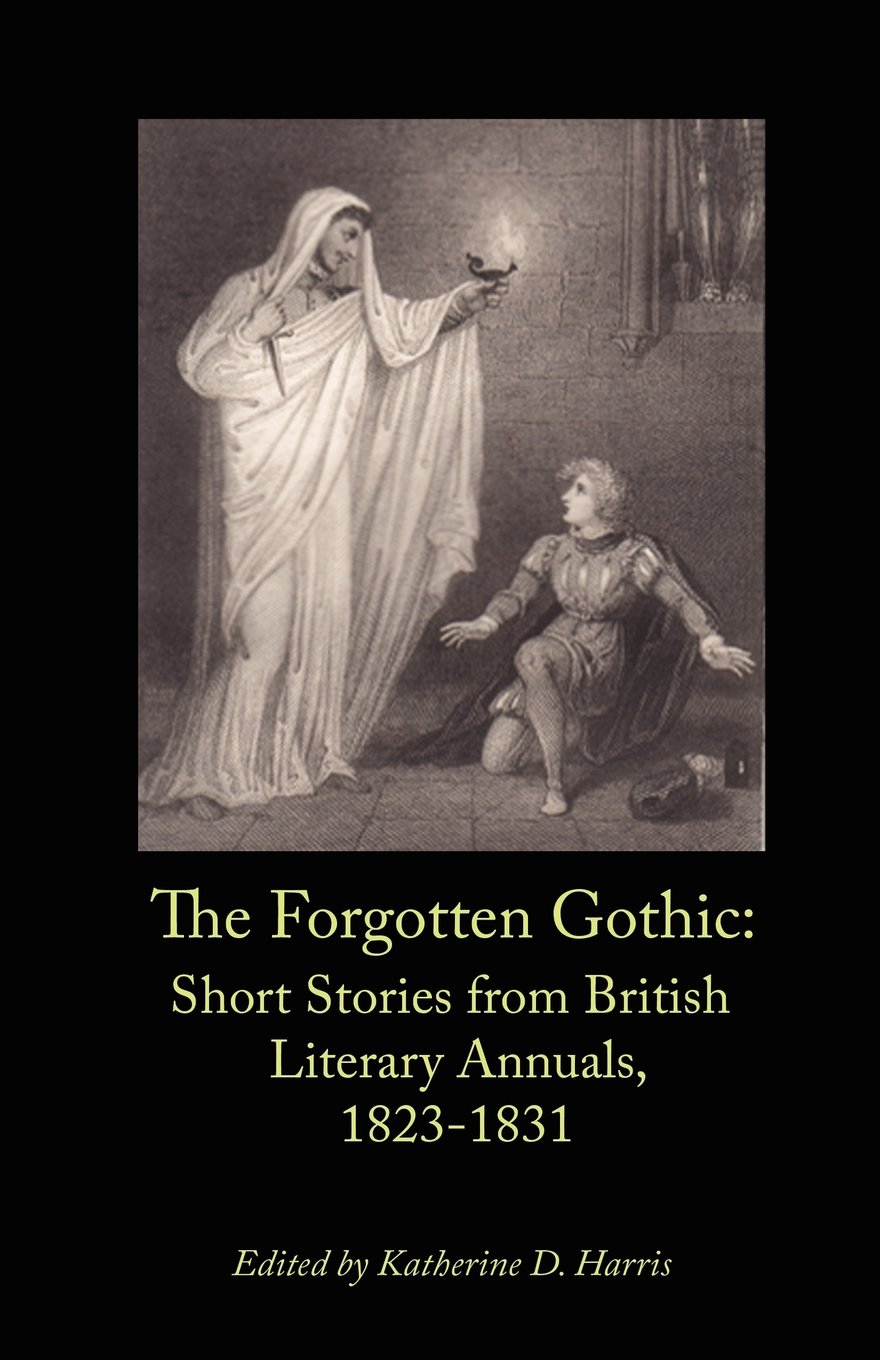 The Forgotten Gothic: Short Stories from British Literary Annuals, 1823-1831 (zittaw press, 2012)
The Forgotten Gothic: Short Stories from British Literary Annuals, 1823-1831 (zittaw press, 2012)
This astonishing collection of 95 rare Gothic tales from British Literary Annuals tales takes us further than perhaps eighteenth or nineteenth-century scholars are comfortable with – to the Gothic's afterlife. Once touted as a literary "dead zone" – the Annuals of the 1820s and 30s are unexpectedly populated with dozens of terrifying and horrific Gothic tales. A groundbreaking collection, Forgotten Gothic illustrates the continued development of the Gothic genre even after its supposed death in 1820.
Allison Johnson
The Scars We Carve: Bodies and Wounds in Civil War (LSU Press, April 2019)
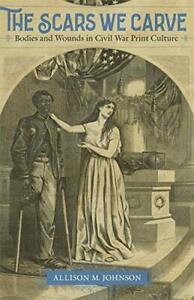 In The Scars We Carve: Bodies and Wounds in Civil War Print Culture, Allison M. Johnson considers the ubiquitous images of bodies―white and black, male
and female, soldier and civilian―that appear throughout newspapers, lithographs, poems,
and other texts circulated during and in the decades immediately following the Civil
War. Rather than dwelling on the work of well-known authors, The Scars We Carve uncovers a powerful archive of Civil War–era print culture in which the individual
body and its component parts, marked by violence or imbued with rhetorical power,
testify to the horrors of war and the lasting impact of the internecine conflict.
In The Scars We Carve: Bodies and Wounds in Civil War Print Culture, Allison M. Johnson considers the ubiquitous images of bodies―white and black, male
and female, soldier and civilian―that appear throughout newspapers, lithographs, poems,
and other texts circulated during and in the decades immediately following the Civil
War. Rather than dwelling on the work of well-known authors, The Scars We Carve uncovers a powerful archive of Civil War–era print culture in which the individual
body and its component parts, marked by violence or imbued with rhetorical power,
testify to the horrors of war and the lasting impact of the internecine conflict.
Religion and Its Reformation in America, Beginnings to 1730: An Anthology of Primary Sources
 Anthology documenting anglophone Christianity in North America.
Anthology documenting anglophone Christianity in North America.
The Left-Armed Corps: Writings by Amputee Civil War Veterans (LSU Press, 2022)
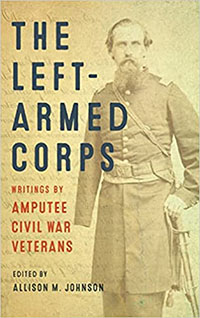 The Left-Armed Corps collects and annotates a unique and little-known body of Civil War literature: narrative
sketches, accounts, and poetry by veterans who lost the use of their right arms due
to wounds sustained during the conflict and who later competed in left-handed penmanship
contests in 1865 and 1866. Editor Allison M. Johnson organizes the selections thematically
in order to highlight issues crucial to the experiences of Civil War soldiers, veterans,
and amputees, offering invaluable insights into the ways in which former fighting
men understood and commemorated their service and sacrifice. A detailed introduction
provides background information on the contests and comments on the literary and historical
significance of the veterans and their writings. Chapter subjects include political
and philosophical treatises by veterans, amateur but poignant poetic testaments, and
graphic accounts of wounding and amputation. The Left-Armed Corps makes accessible this archive of powerful testimony and creative expression from
Americans who fought to preserve the Union and end slavery.
The Left-Armed Corps collects and annotates a unique and little-known body of Civil War literature: narrative
sketches, accounts, and poetry by veterans who lost the use of their right arms due
to wounds sustained during the conflict and who later competed in left-handed penmanship
contests in 1865 and 1866. Editor Allison M. Johnson organizes the selections thematically
in order to highlight issues crucial to the experiences of Civil War soldiers, veterans,
and amputees, offering invaluable insights into the ways in which former fighting
men understood and commemorated their service and sacrifice. A detailed introduction
provides background information on the contests and comments on the literary and historical
significance of the veterans and their writings. Chapter subjects include political
and philosophical treatises by veterans, amateur but poignant poetic testaments, and
graphic accounts of wounding and amputation. The Left-Armed Corps makes accessible this archive of powerful testimony and creative expression from
Americans who fought to preserve the Union and end slavery.
Erik Johnson
How to Teach a Play: Essential Exercises for Popular Plays
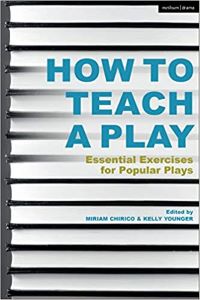 Most students encounter drama as they do poetry and fiction – as literature to be
read – but never experience the performative nature of theater. How to Teach a Play provides new strategies for teaching dramatic literature and offers practical, play-specific
exercises that demonstrate how performance illuminates close reading of the text.
This practical guide provides a new generation of teachers and theatre professionals
the tools to develop their students' performative imagination.
Most students encounter drama as they do poetry and fiction – as literature to be
read – but never experience the performative nature of theater. How to Teach a Play provides new strategies for teaching dramatic literature and offers practical, play-specific
exercises that demonstrate how performance illuminates close reading of the text.
This practical guide provides a new generation of teachers and theatre professionals
the tools to develop their students' performative imagination.
Revathi Krishnaswamy
Postcolonial and the Global Edited by Revathi Krishnaswamy, John C. Hawley, John C. Hawley (University of Minnesota Press, 2007)
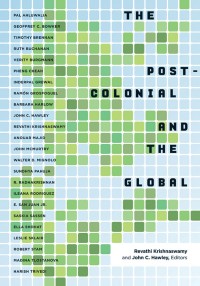 This interdisciplinary work brings the humanities and social sciences into dialogue
by examining issues such as globalized capital, discourses of antiterrorism, and identity
politics. Essayists from the fields of postcolonial studies and globalization theory
address the ethical and pragmatic ramifications of opposing interpretations of these
issues and, for the first time, seek common ground.
This interdisciplinary work brings the humanities and social sciences into dialogue
by examining issues such as globalized capital, discourses of antiterrorism, and identity
politics. Essayists from the fields of postcolonial studies and globalization theory
address the ethical and pragmatic ramifications of opposing interpretations of these
issues and, for the first time, seek common ground.
Effeminism: The Economy of Colonial Desire(University of Michigan Press, 1999)
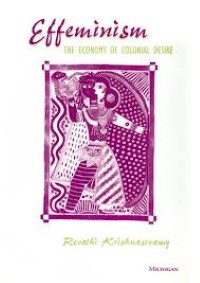 A fascinating study of "the inevitable intimacy between colonizer and colonized," Effeminism: The Economy of Colonial Desire attempts to chart the flow of colonial desire by examining the complex encodings
of fears, fascinations, and anxieties in the works of British writers in India. The
author examines the works of Flora Annie Steel, Rudyard Kipling, and E. M. Forster,
and finds their works to be deeply implicated in the politics of colonial rule and
anticolonial resistance. Krishnaswamy refuses to characterize the colonial encounter
in terms of unchanging and monolithic Manichean oppositions, repeatedly drawing attention
to fissures, contradictions, and slippages that attend the production of English manliness
and Indian effeminacy. By restoring both the political in the unconscious and the
unconscious in the political, the book proposes to understand colonialism in terms
of historical failure, ideological inadequacy, and political contention.
A fascinating study of "the inevitable intimacy between colonizer and colonized," Effeminism: The Economy of Colonial Desire attempts to chart the flow of colonial desire by examining the complex encodings
of fears, fascinations, and anxieties in the works of British writers in India. The
author examines the works of Flora Annie Steel, Rudyard Kipling, and E. M. Forster,
and finds their works to be deeply implicated in the politics of colonial rule and
anticolonial resistance. Krishnaswamy refuses to characterize the colonial encounter
in terms of unchanging and monolithic Manichean oppositions, repeatedly drawing attention
to fissures, contradictions, and slippages that attend the production of English manliness
and Indian effeminacy. By restoring both the political in the unconscious and the
unconscious in the political, the book proposes to understand colonialism in terms
of historical failure, ideological inadequacy, and political contention.
J. Michael Martinez
Tarta Americana
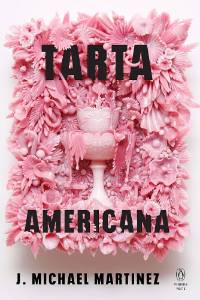 Ragged and raging across the spectrums of cognition, race, and gender, Tarta Americana
lyrically envisions forms of survival outside neuronormative perceptions and histories.
Against the recent tide of white nationalism in the United States, Tarta Americana
finds a rhinestone in Ritchie Valens, the rock and roll legend, surfacing across time
and bodies, genders and sounds, displacing the linear unfolding of desire and biography.
Valens, the embodiment of corporeal transcendence, guides Martinez as he expresses
his own neurodiversity, his struggles and triumphs, interrogating memory, gender,
and race, traversing pain in search of compassion and joy. Tarta Americana, tarred
and glittering, melodic in its screams, overdrives text and space in chase of American
politics that could, at last, harmonize love with redemption.
Ragged and raging across the spectrums of cognition, race, and gender, Tarta Americana
lyrically envisions forms of survival outside neuronormative perceptions and histories.
Against the recent tide of white nationalism in the United States, Tarta Americana
finds a rhinestone in Ritchie Valens, the rock and roll legend, surfacing across time
and bodies, genders and sounds, displacing the linear unfolding of desire and biography.
Valens, the embodiment of corporeal transcendence, guides Martinez as he expresses
his own neurodiversity, his struggles and triumphs, interrogating memory, gender,
and race, traversing pain in search of compassion and joy. Tarta Americana, tarred
and glittering, melodic in its screams, overdrives text and space in chase of American
politics that could, at last, harmonize love with redemption.
Brook McClurg
A Dictionary of Modern Consternation
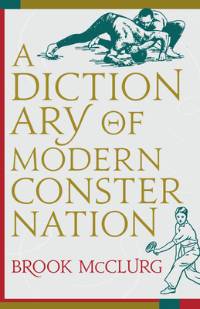 A Dictionary of Modern Consternation is a genre-bending nonfiction lyric following one family through the years from the
financial crisis to the COVID-19 pandemic. In this cheeky dictionary-shaped exploration
of how language can often alienate and dehumanize, weakening feelings of community
with societal trends that subsume individual lives, Brook McClurg offers a footnote
narrative of an international life pursuing the business of words.
A Dictionary of Modern Consternation is a genre-bending nonfiction lyric following one family through the years from the
financial crisis to the COVID-19 pandemic. In this cheeky dictionary-shaped exploration
of how language can often alienate and dehumanize, weakening feelings of community
with societal trends that subsume individual lives, Brook McClurg offers a footnote
narrative of an international life pursuing the business of words.
What starts as a lighthearted academic exploration becomes real when the pandemic hits—at the letter P—and the ability to treat each other humanely suddenly has grave consequences. Questioning the ways specialized jargon in language—often corporate, legal, and militaristic in nature—encroaches on our feelings of community and responsibility to one another, McClurg employs an abecedarian format, concealing his meaningful and sensitive explorations of personal strife inside a more formal facade. A Dictionary of Modern Consternation reveals its subjective viewpoint and ironic tone over the course of the text, confronting themes of loneliness and isolation, global strife and endless war, and intimacy, love, and family.
With approximately 500 satirical dictionary entries and 143 flash essays as footnotes, this experimental memoir is filled with satirical definitions, pseudo-aphorisms, and inquisitions into words or phrases. A Dictionary of Modern Consternation is for general readers, collectors, book-as-art lovers, and anyone interested in the political economy of language, as well as graduate classes exploring experimental forms.
Linda Mitchell
Portraits of Medieval Women: Family, Marriage and Social Relations in Thirteenth Century England (Palgrave MacMillan, 2003)
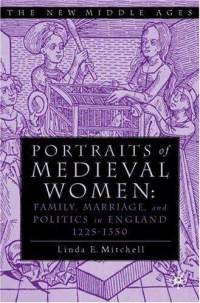 Although numerous studies of medieval women and a number of biographies of medieval
queens and noblewomen have appeared in recent years, comparatively few studies have
sought to combine biographical and prosopographical approaches in order to develop
portraits of specific women in order to highlight different life experiences of medieval
women. The individual chapters can be read as separate histories of their specific
subjects as well as case studies which together provide a coherent picture of the
medieval English noblewoman.
Although numerous studies of medieval women and a number of biographies of medieval
queens and noblewomen have appeared in recent years, comparatively few studies have
sought to combine biographical and prosopographical approaches in order to develop
portraits of specific women in order to highlight different life experiences of medieval
women. The individual chapters can be read as separate histories of their specific
subjects as well as case studies which together provide a coherent picture of the
medieval English noblewoman.
Keenan Norris
By the Lemon Tree (Nomadic Press, 2003)
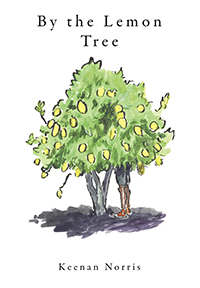 Set in the Central California countryside and the Southern California desert, By the Lemon Tree’s old school stories chronicle the collision of wide-eyed childhood with the end
of lives human and animal. In “Twice Good” a downtrodden city administrator shows
up for a Black Panther protest forty years too late. “Funeral in Fresno” introduces
us to an impatient reverend who is forced to confront his past and his future, while
in the title story, a young boy born and raised in East Oakland bears witness to life
and death in an ancient rural world.
Set in the Central California countryside and the Southern California desert, By the Lemon Tree’s old school stories chronicle the collision of wide-eyed childhood with the end
of lives human and animal. In “Twice Good” a downtrodden city administrator shows
up for a Black Panther protest forty years too late. “Funeral in Fresno” introduces
us to an impatient reverend who is forced to confront his past and his future, while
in the title story, a young boy born and raised in East Oakland bears witness to life
and death in an ancient rural world.
Brother and the Dancer (Heyday Books, 2013)
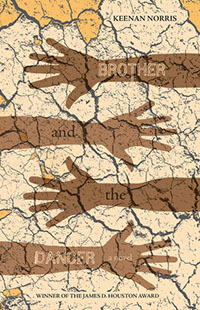 Winner of the 2012 James D. Houston Award, Keenan Norris's first novel is a beautiful,
gritty, coming-of-age tale about two young African Americans in the San Bernardino
Valley--a story of exceptional power, lyricism, and depth. Erycha and Touissant live
only a few miles apart in the city of Highland, but their worlds are starkly separated
by the lines of class, violence, and history. In alternating chapters that touch and
intertwine only briefly, Brother and the Dancer follows their adolescence and young
adulthood on two sides of the city, the luminous San Bernardino range casting its
hot shade over their separate tales in an unflinching vision of black life in Southern
California.
Winner of the 2012 James D. Houston Award, Keenan Norris's first novel is a beautiful,
gritty, coming-of-age tale about two young African Americans in the San Bernardino
Valley--a story of exceptional power, lyricism, and depth. Erycha and Touissant live
only a few miles apart in the city of Highland, but their worlds are starkly separated
by the lines of class, violence, and history. In alternating chapters that touch and
intertwine only briefly, Brother and the Dancer follows their adolescence and young
adulthood on two sides of the city, the luminous San Bernardino range casting its
hot shade over their separate tales in an unflinching vision of black life in Southern
California.
The Confession of Copeland Cane (The Unnamed Press, 2021)
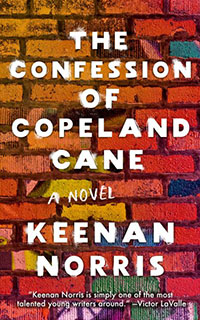 He is also just a regular teenager coming up in a terrifying world. A slightly eccentric,
flip-phone loving kid with analog tendencies and a sideline hustling sneakers, the
boundaries of Copeland’s life are demarcated from the jump by urban toxicity, an educational
apparatus with confounding intentions, and a police state that has merged with media
conglomerates―the highly-rated Insurgency Alert Desk that surveils and harasses his
neighborhood in the name of anti-terrorism.
He is also just a regular teenager coming up in a terrifying world. A slightly eccentric,
flip-phone loving kid with analog tendencies and a sideline hustling sneakers, the
boundaries of Copeland’s life are demarcated from the jump by urban toxicity, an educational
apparatus with confounding intentions, and a police state that has merged with media
conglomerates―the highly-rated Insurgency Alert Desk that surveils and harasses his
neighborhood in the name of anti-terrorism.
Recruited by the nearby private school even as he and his folks face eviction, Copeland is doing his damnedest to do right by himself, for himself. And yet the forces at play entrap him in a reality that chews up his past and obscures his future. Copeland’s wry awareness of the absurd keeps life passable, as do his friends and their surprising array of survival skills. And yet in the aftermath of a protest rally against police violence, everything changes, and Copeland finds himself caught in the flood of history.
Set in East Oakland, California in a very near future, The Confession of Copeland Cane introduces us to a prescient and contemporary voice, one whose take on coming of age in America becomes a startling reflection of our present moment.
Kristian O'Hare
Tennessee Williams Literary Festival Writing Contest 1st Place Winner—Very Short Fiction
"Our Judge and TWF20 Speaker Jac Jemc had this to say about the winning story:
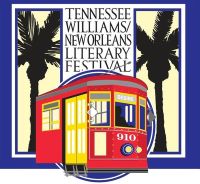 There is so much to admire in Hard Swallow: the activated details- "the moonlight fights with the neon", the sensory descriptions-
a mouth that plainspoken yet inscrutable dialogue- "Blue is wrongfor roses." what
made me choose this story though is the vivid and affecting shifts in emotional register,
fromthe absurdity of a sideshow-like act in a strip club to the melancholy, tender
encounter outside the bar, to the random loss of romantic opportunity, and back again.
The story runs a concise, perfect lap through the evening of an outsider."
There is so much to admire in Hard Swallow: the activated details- "the moonlight fights with the neon", the sensory descriptions-
a mouth that plainspoken yet inscrutable dialogue- "Blue is wrongfor roses." what
made me choose this story though is the vivid and affecting shifts in emotional register,
fromthe absurdity of a sideshow-like act in a strip club to the melancholy, tender
encounter outside the bar, to the random loss of romantic opportunity, and back again.
The story runs a concise, perfect lap through the evening of an outsider."
Daniel Rivers
Grizzly Country: Settler Worlding and the Politics of Species on the California Frontier
Grizzly Country draws together an archive of literary, visual, and popular culture to examine the
ways that white settlers transformed the California Grizzly (Ursus Arctos Californicus)
into both a symbol of imperial manhood and an embodiment of colonial anxieties about
California’s seeming untameability. While attending to the environmental and colonial
histories of wilderness enclosure, Native enslavement, and grizzly eradication, this
article argues that popular representations of wild, unruly grizzlies were often used
to frame Native nations and the undomesticated outdoors as obstacles to a properly
domesticated and commercially productive
U.S. California.
Avantika Rohatgi
Global Rights and Perceptions: A Call to Awareness and Action (Third Edition)
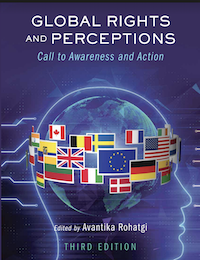 In Global Rights and Perceptions: Call to Awareness and Action students read from a wide variety of original sources ― foreign policy journals,
non-fiction books, medical journals, and current affairs magazines, including the
New Statesman, the Journal of Medical Ethics, Foreign Policy, and the Journal of American and Comparative Culture. The textbook also includes representative student papers on global issues to stimulate
students’ imaginations and exemplify compelling writing strategies. This varied exposure
gives students several gateways through which to approach complex social issues and
raises awareness about how widespread these issues are and how seriously they are
being considered by academic, journalistic, literary, and social entities. It includes
current articles on Social Media, Video Gaming, Trump's Immigration Policies and Artificial Intelligence.
In Global Rights and Perceptions: Call to Awareness and Action students read from a wide variety of original sources ― foreign policy journals,
non-fiction books, medical journals, and current affairs magazines, including the
New Statesman, the Journal of Medical Ethics, Foreign Policy, and the Journal of American and Comparative Culture. The textbook also includes representative student papers on global issues to stimulate
students’ imaginations and exemplify compelling writing strategies. This varied exposure
gives students several gateways through which to approach complex social issues and
raises awareness about how widespread these issues are and how seriously they are
being considered by academic, journalistic, literary, and social entities. It includes
current articles on Social Media, Video Gaming, Trump's Immigration Policies and Artificial Intelligence.
Ryan Skinnell
Reinventing (with) Theory in Rhetoric & Writing Studies: Essays in Honor of Sharon Crowley. Co-edited w/ Andrea Alden, Kendall Gerdes, & Judy Holiday. (Logan, UT: Utah State UP, 2019).
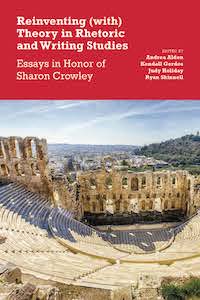 Reinventing (with) Theory in Rhetoric and Writing Studies collects sixteen chapters by established and emerging scholars that take up and extend
the practices of inventive, rhetorical theorizing that characterize Sharon Crowley’s
body of work. The book shows that doing theory is a contingent and continual rhetorical
process that is indispensable for understanding situations and their potential significance—and
for discovering the available means of persuasion.
Reinventing (with) Theory in Rhetoric and Writing Studies collects sixteen chapters by established and emerging scholars that take up and extend
the practices of inventive, rhetorical theorizing that characterize Sharon Crowley’s
body of work. The book shows that doing theory is a contingent and continual rhetorical
process that is indispensable for understanding situations and their potential significance—and
for discovering the available means of persuasion.
Rhetoric’s Demagogue | Demagoguery’s Rhetoric. Ed. Ryan Skinnell & Jillian Murphy. (Special Issue of Rhetoric Society Quarterly 49.3. 2019).
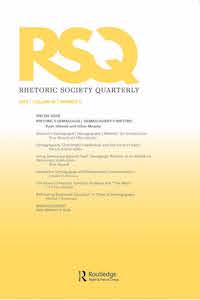 Rhetoric’s Demagogue | Demagoguery’s Rhetoric is a special issue of Rhetoric Society Quarterly edited by Ryan Skinnell and SJSU
alumna Jillian Murphy. In this issue, the contributors consider what rhetoric can
teach us about demagoguery—what it is, how it works, and what we can do to address
it.
Rhetoric’s Demagogue | Demagoguery’s Rhetoric is a special issue of Rhetoric Society Quarterly edited by Ryan Skinnell and SJSU
alumna Jillian Murphy. In this issue, the contributors consider what rhetoric can
teach us about demagoguery—what it is, how it works, and what we can do to address
it.
Faking the News: What Rhetoric Can Teach Us About Donald J. Trump. Ed. Ryan Skinnell. (Exeter, UK: Societas, 2018).
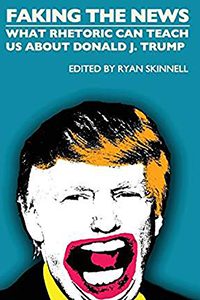 In Faking the News: What Rhetoric Can Teach Us About Donald J. Trump, eleven prominent rhetoric experts explain how Donald Trump’s persuasive language
and symbols work.
In Faking the News: What Rhetoric Can Teach Us About Donald J. Trump, eleven prominent rhetoric experts explain how Donald Trump’s persuasive language
and symbols work.
Bureaucracy: A Love Story. Co-edited w/ Gabriel Cervantes, Dahlia Porter, & Kelly Wisecup. (Denton, TX: Aquiline Books, 2018).
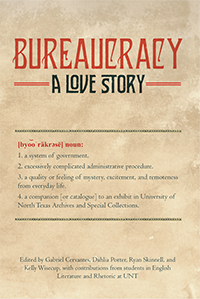 Bureaucracy: A Love Story draws together research done by scholars and students in the Special Collections
at the University of North Texas to illuminate how bureaucracy structures our contemporary
lives across a range of domains.
Bureaucracy: A Love Story draws together research done by scholars and students in the Special Collections
at the University of North Texas to illuminate how bureaucracy structures our contemporary
lives across a range of domains.
Conceding Composition: A Crooked History of Composition’s Institutional Fortunes. (Logan, UT: Utah State University Press, 2016).
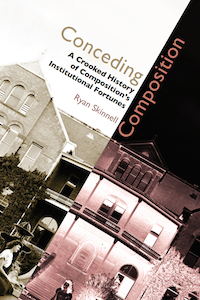 Conceding Composition is a wide-ranging historical examination of composition’s institutional value in
American higher education. The book considers the rhetorical, political, organizational,
institutional, and promotional options that conceding composition opened up for institutions
of higher education and considers what the first-year course and the discipline might
look like with composition’s transience reimagined not as a barrier but as a consummate
institutional value.
Conceding Composition is a wide-ranging historical examination of composition’s institutional value in
American higher education. The book considers the rhetorical, political, organizational,
institutional, and promotional options that conceding composition opened up for institutions
of higher education and considers what the first-year course and the discipline might
look like with composition’s transience reimagined not as a barrier but as a consummate
institutional value.
What We Wish We’d Known: Negotiating Graduate School. Co-edited w/ Judy Holiday & Christine Vassett. (Southlake, TX: Fountainhead Press, 2015).
What We Wish We’d Known: Negotiating Graduate School contains 15 chapters written by graduate students who explore the ways they have made sense of, and made choices about, graduate school challenges, including choosing a committee, teaching as a graduate student, and writing a dissertation. In addition to the main chapters, there are 28 responses to the major chapters written by graduate students from around the country.
Alan Soldofsky
Compendium: A Collection of Thoughts on Prosody, by Donald Justice. Edited by David Koehn & Alan Soldofsky (Omindawn Publishing 2017).
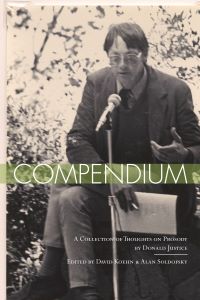 As prosody is the very medium of the poet’s domain, Donald Justice saw prosody as
a set of nomenclatures for the poet composers to use in making their music. The collage
process Justice employed to present his instructional materials possesses a composer’s
quality, the structure of which possesses a unique beauty. His insights serve as a
sort of de facto taxonomy, an organically designed system that he uses to present
his lecture on each respective aspect of the evolution of poetic form. There is no
formal thesis here, but rather a kind of scrapbook that has a broader motive. The
material possesses no hidden secrets; the treasures lie in plain sight and simply
need be discerned to open the artist’s mind to their possibilities.
As prosody is the very medium of the poet’s domain, Donald Justice saw prosody as
a set of nomenclatures for the poet composers to use in making their music. The collage
process Justice employed to present his instructional materials possesses a composer’s
quality, the structure of which possesses a unique beauty. His insights serve as a
sort of de facto taxonomy, an organically designed system that he uses to present
his lecture on each respective aspect of the evolution of poetic form. There is no
formal thesis here, but rather a kind of scrapbook that has a broader motive. The
material possesses no hidden secrets; the treasures lie in plain sight and simply
need be discerned to open the artist’s mind to their possibilities.
In the Buddha Factory (Truman State University Press, 2013)
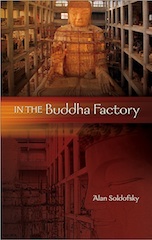 Captivating and truthful, In the Buddha Factory is rich in detail, honest in tragedy,
and poignant in observation. Through a mastery of style and language placed against
the backdrop of Silicon Valley, Soldofsky explores the tension of opposites of place
and no place, rich and poor, and finite and the limitless. These poems capture the
intricacies of family, aging, and identity, and renders them in words both insightful
and lyrical.
Captivating and truthful, In the Buddha Factory is rich in detail, honest in tragedy,
and poignant in observation. Through a mastery of style and language placed against
the backdrop of Silicon Valley, Soldofsky explores the tension of opposites of place
and no place, rich and poor, and finite and the limitless. These poems capture the
intricacies of family, aging, and identity, and renders them in words both insightful
and lyrical.
Nick Taylor
Double Switch (Penguin Random House, 2016)
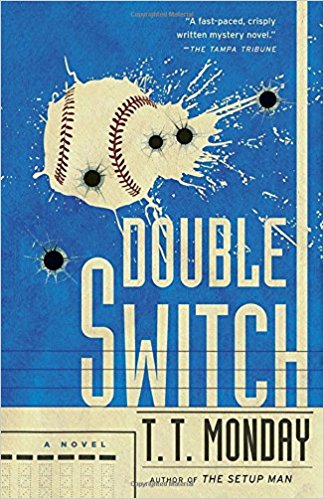 T. T. MONDAY is the pseudonym of novelist Nick Taylor.
T. T. MONDAY is the pseudonym of novelist Nick Taylor.
Relief pitcher/private investigator Johnny Adcock doesn’t have an office; he has the bullpen. That’s where he meets Tiff Tate, the femme-fatale stylist responsible for half the looks in Major League Baseball, from Brian Wilson’s beard to Big Papi’s gold ropes. Tiff has a problem. Her new client, the rookie phenom Yonel Ruiz, has been threatened by a cartel of smugglers. Adcock is her last best hope. As he embarks on this potentially deadly mission, Adcock tangoes with a mysterious, sexy assassin known only as La Loba. And he still has the playoffs to worry about.
The Setup Man (Penguin Random House, 2014)
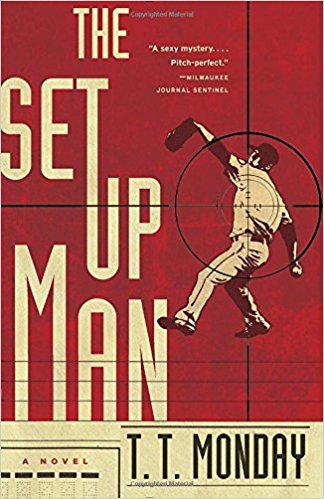 T. T. MONDAY is the pseudonym of novelist Nick Taylor.
T. T. MONDAY is the pseudonym of novelist Nick Taylor.
Johnny Adcock is an aging Major League pitcher, who moonlights as a private investigator. Major League Baseball, as it turns out, is a prime source of employment for a discreet detective who has both the brains and the brawn to handle the unique problems of professional athletes. On the bus after a game, teammate Frankie Herrera confides in Adcock that he has a “problem with his wife.” It sounds like the standard story of a pro athlete’s marriage gone sour. However, when Frankie dies in a car crash, Adcock knows there are way too many questions still unanswered, and he dives head first into the most dangerous investigation of his budding second career.
Mary Warner
Critical Insights: Historical Fiction
Editor: Virginia Brackett, Park University, Missouri (January 2018)
 In combination this volume’s chapters open wide a door to discussion of the importance
and the joy of historical fiction for readers at all levels. They also invite readers
to compare fictional presentations of “true” events and persons to that of traditionally
understood historical narratives. Such consideration may result in a clearer understanding
of the nature of historical fiction on the part of readers and writers alike.
In combination this volume’s chapters open wide a door to discussion of the importance
and the joy of historical fiction for readers at all levels. They also invite readers
to compare fictional presentations of “true” events and persons to that of traditionally
understood historical narratives. Such consideration may result in a clearer understanding
of the nature of historical fiction on the part of readers and writers alike.
Adolescents in the Search for Meaning: Tapping the Powerful Resource of Story (Scarecrow Press, 2006)
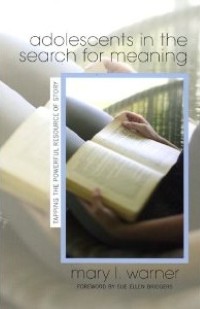 As is painfully evident from the reports of school shootings, gang violence, and adolescent
suicide, many teens live troubled lives. Even those who live a "normal" life are confronted
by some of the challenges adults face. However, few of them have the same resources
as adults for surviving such challenges. In addition, teens are also engaged in establishing
independence and finding their identities. Building on the idea that "story" is a
powerful source of meaning, particularly those stories that resonate with our own
lives, Mary Warner suggests that the stories of other young adults offer a resource
yet to be fully tapped. As such, readers are provided with insight into the young
adult perspective from the results of a survey of over 1400 teens and through feedback
from authors of young adult literature.
As is painfully evident from the reports of school shootings, gang violence, and adolescent
suicide, many teens live troubled lives. Even those who live a "normal" life are confronted
by some of the challenges adults face. However, few of them have the same resources
as adults for surviving such challenges. In addition, teens are also engaged in establishing
independence and finding their identities. Building on the idea that "story" is a
powerful source of meaning, particularly those stories that resonate with our own
lives, Mary Warner suggests that the stories of other young adults offer a resource
yet to be fully tapped. As such, readers are provided with insight into the young
adult perspective from the results of a survey of over 1400 teens and through feedback
from authors of young adult literature.